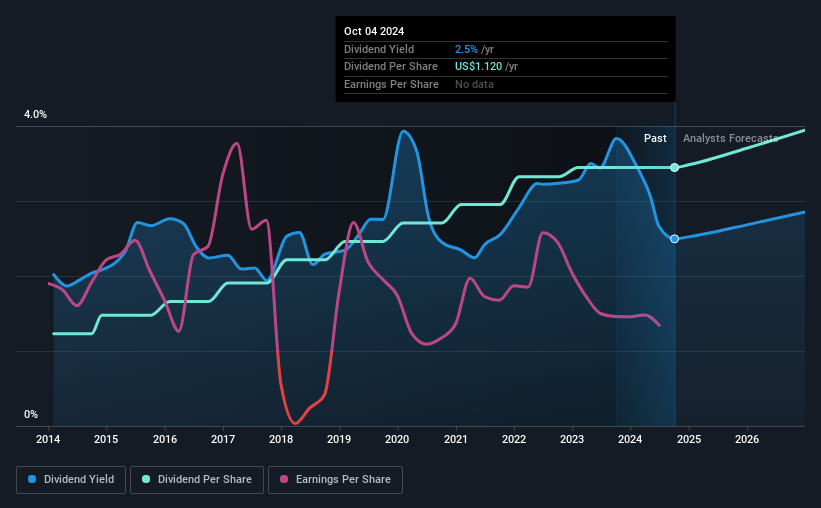Corning (NYSE:GLW) Is Due To Pay A Dividend Of $0.28
The board of Corning Incorporated (NYSE:GLW) has announced that it will pay a dividend on the 13th of December, with investors receiving $0.28 per share. This makes the dividend yield 2.5%, which will augment investor returns quite nicely.
View our latest analysis for Corning
Corning's Projected Earnings Seem Likely To Cover Future Distributions
A big dividend yield for a few years doesn't mean much if it can't be sustained. Prior to this announcement, the company was paying out 218% of what it was earning. It will be difficult to sustain this level of payout so we wouldn't be confident about this continuing.
Analysts expect a massive rise in earnings per share in the next year. If recent patterns in the dividend continue, we could see the payout ratio reaching 53% which is fairly sustainable.

Corning Has A Solid Track Record
The company has been paying a dividend for a long time, and it has been quite stable which gives us confidence in the future dividend potential. Since 2014, the dividend has gone from $0.40 total annually to $1.12. This works out to be a compound annual growth rate (CAGR) of approximately 11% a year over that time. We can see that payments have shown some very nice upward momentum without faltering, which provides some reassurance that future payments will also be reliable.
The Dividend Has Limited Growth Potential
The company's investors will be pleased to have been receiving dividend income for some time. Unfortunately things aren't as good as they seem. Corning's EPS has fallen by approximately 22% per year during the past five years. A sharp decline in earnings per share is not great from from a dividend perspective. Even conservative payout ratios can come under pressure if earnings fall far enough. It's not all bad news though, as the earnings are predicted to rise over the next 12 months - we would just be a bit cautious until this becomes a long term trend.
The Dividend Could Prove To Be Unreliable
Overall, it's nice to see a consistent dividend payment, but we think that longer term, the current level of payment might be unsustainable. In the past the payments have been stable, but we think the company is paying out too much for this to continue for the long term. Overall, we don't think this company has the makings of a good income stock.
Market movements attest to how highly valued a consistent dividend policy is compared to one which is more unpredictable. Meanwhile, despite the importance of dividend payments, they are not the only factors our readers should know when assessing a company. Case in point: We've spotted 4 warning signs for Corning (of which 1 is a bit concerning!) you should know about. If you are a dividend investor, you might also want to look at our curated list of high yield dividend stocks.
New: AI Stock Screener & Alerts
Our new AI Stock Screener scans the market every day to uncover opportunities.
• Dividend Powerhouses (3%+ Yield)
• Undervalued Small Caps with Insider Buying
• High growth Tech and AI Companies
Or build your own from over 50 metrics.
Have feedback on this article? Concerned about the content? Get in touch with us directly. Alternatively, email editorial-team (at) simplywallst.com.
This article by Simply Wall St is general in nature. We provide commentary based on historical data and analyst forecasts only using an unbiased methodology and our articles are not intended to be financial advice. It does not constitute a recommendation to buy or sell any stock, and does not take account of your objectives, or your financial situation. We aim to bring you long-term focused analysis driven by fundamental data. Note that our analysis may not factor in the latest price-sensitive company announcements or qualitative material. Simply Wall St has no position in any stocks mentioned.
About NYSE:GLW
Corning
Operates in optical communications, display technologies, environmental technologies, specialty materials, and life sciences businesses.
High growth potential with proven track record and pays a dividend.
Similar Companies
Market Insights
Community Narratives



